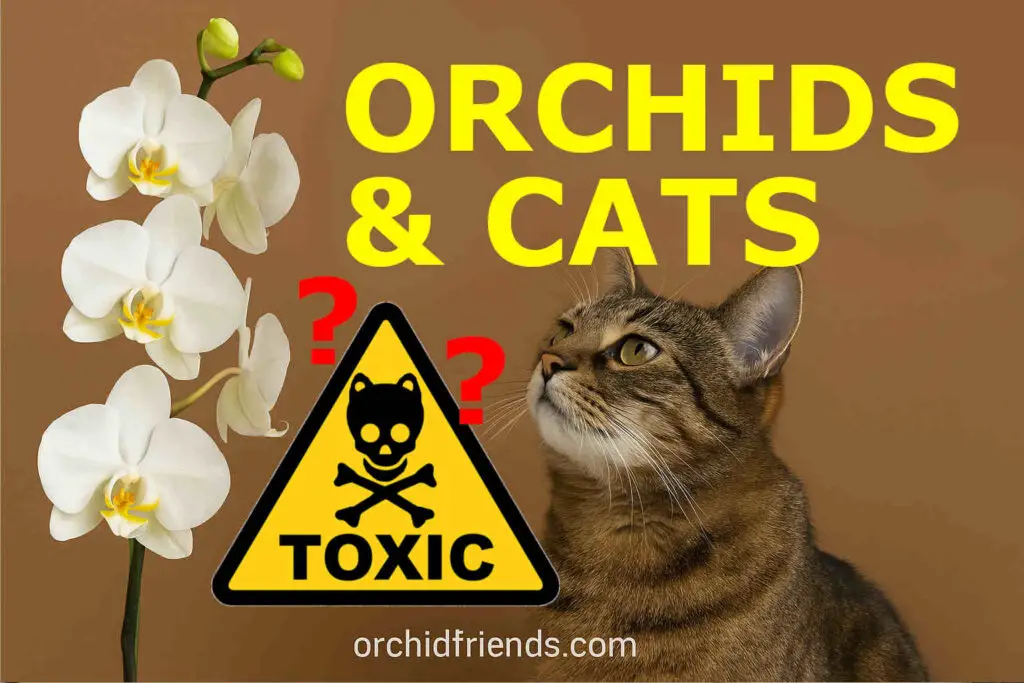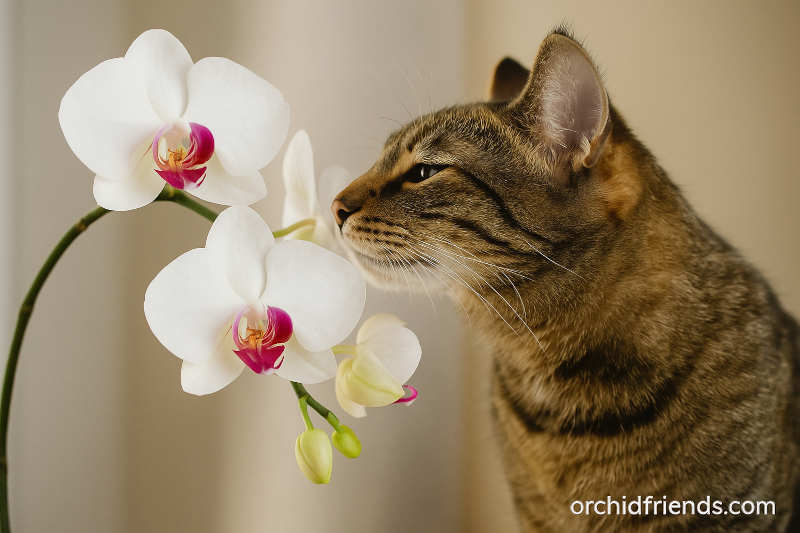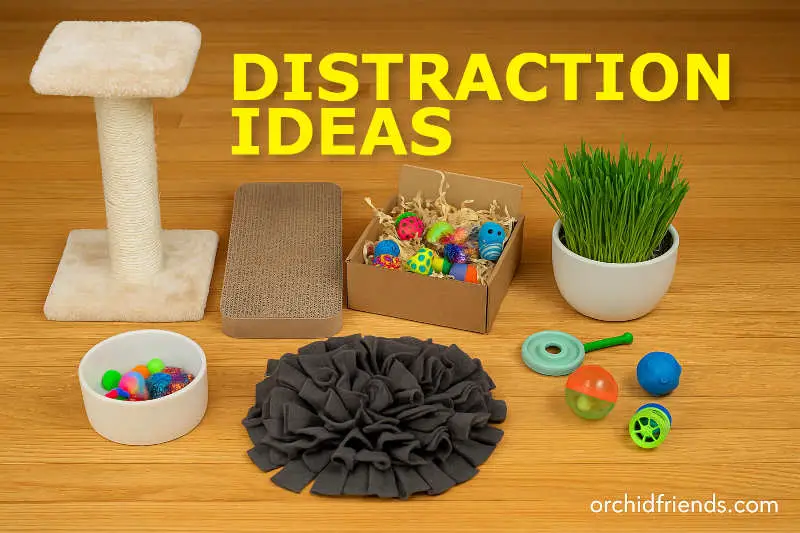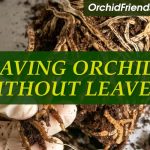
** This post is written and edited by a human being **
Being both a cat lover AND a plant lover can be one of those tricky combos that either works beautifully or brings its fair share of challenges at home. With curious cats and gorgeous orchids under one roof (and neither are going anywhere, as it should be!), you’ve arrived to a valid question: Could my orchids actually be harmful to my feline friend?
I’ve received several messages from concerned cat parents wondering about this, so you’re not alone—and for the record, I salute you for it! 🙌 Knowledge is power, and better safe than sorry. We want to protect our fur babies. Cats are naturally nosy little creatures; they love to sniff, swat, and even occasionally (oops!) chew on houseplants. Since some plants are genuinely toxic to pets, it’s important to double-check what you have in your home.
What exactly makes a plant dangerous to cats? There are certain chemicals in the plant, such as oxalates, alkaloids, or essential oils, that can upset your cat’s stomach, harm their liver, or in the worst cases, even affect their heart. Sometimes the symptoms are mild, like a bit of drooling, vomiting, or acting a little woozy. But in other cases, it can get seriously dangerous. That’s why we pet parents need to stay on our toes.
That being said, here’s the good news: Phalaenopsis orchids are not on the list of toxic houseplants. Hooray! In fact, the ASPCA (American Society for the Prevention of Cruelty to Animals) maintains a database of plants that are toxic or non-toxic to pets, and most orchids fall into the “non-toxic” category.
Of course, “non-toxic” doesn’t mean your cat should eat an orchid—just that it’s not likely to cause serious harm if your little whiskered troublemaker were to chew on it. Still, knowing what’s safe and what’s not can really ease your mind.
Below, we’ll look deeper into specific types of orchids and how they interact with our feline friends.

Orchid Safety – What the Science Says
Let’s start by addressing the main issue: are orchids actually poisonous to cats? The short answer is no, not the most common ones. Most houseplant orchids, like our beloved Phalaenopsis, are considered non-toxic to cats.
But just because an orchid isn’t poisonous doesn’t mean it’s totally harmless. As cats are curious, they might be tempted to chew on the leaves, play with the flowers, or even take a bite out of the aerial roots. While such behavior usually won’t send you speeding to the vet, it could cause a mild tummy upset. Think of it like a toddler sneaking a bite of something they shouldn’t—probably fine, but not ideal.
Now, you might come across orchid species you haven’t heard of, especially if you’re into collecting them. If you’re unsure about a certain type, the ASPCA’s online database is a great resource. The Orchidaceae botanical family has over 25,000 species in it, but all the most common orchids like Dendrobium, Cattleya, Ludisia, and of course, Phalaenopsis, are all listed as safe. That said, practice caution if you come across with rare or hybrid varieties, or even wild ones, as they might not be as well-documented, or not studied at all. I would keep my cats away from those, for sure.
Additionally, something else to consider: the orchid plant might be safe, but what you use to care for it (fertilizers, pesticides, leaf polish, etc) could pose more of a risk than the plant itself. Cats walk on everything, lick their paws, and explore with their mouths, so it’s worth double-checking your orchid care routine. If the products you’re using are toxic to humans, they’re toxic to cats, too.
But yeah, you can breathe easy. Your kitties are safe with your Phalaenopsis orchids—but a little caution goes a long way. 😽

Creating a Cat-Safe Orchid Space
Now that you know orchids aren’t toxic to cats, you probably still don’t want your feline friend turning your favorite bloom into a snack. Whether you’re trying to protect your cat, your plants, or (most likely) both, it really helps to create a space where everyone can coexist peacefully.
I speak from experience here—I’ve had my share of stress watching my orchids get ambushed by overly curious pets. It’s frustrating! And it’s not just you who gets stressed—long-term nibbling can take a toll on the plants too.
So what can you do?
Start by thinking about where you place your orchids. High shelves, hanging baskets, or wall-mounted planters can work wonders. Generally, the higher, the better. But let’s be honest—cats are basically furry little acrobats. If they really want to reach something, they’ll give it their best shot.
So, try placing orchids in areas your cat doesn’t usually explore. You can also make those areas less appealing using deterrents like citrus peels (cats hate the smell!) or motion-activated sprays (not near carpets, of course).
Got a spare room? Turning it into a plant room could be the perfect solution. Just keep the door closed when you’re not home. Easy.
No extra room? No problem—time to get creative. Could you hang a lightweight curtain in front of your plant shelves? Or throw a fine mesh or insect screen over the plants while you’re away? (I’ve used those sheer window fabrics meant to keep bugs and smog out—they work surprisingly well!)
Here’s another quirky idea: balloons. Yep, some cats are afraid of them. Try tying one or two near the plant shelf and see what your cat thinks. Basically, the goal is to think outside the (litter) box—what could either block your cat from the plants or convince them it’s just not worth the effort?

Distract and redirect
Instead of only thinking how to keep your cat away, also consider how to keep your cat entertained elsewhere. Set up distractions:
- A new scratching post
- A cardboard scratcher
- A box full of toys (or even shredded paper)
- A bowl of cat grass
- A snuffle mat with hidden treats
- Interactive toys
- A YouTube video made for cats (there are plenty of them!)
- Put up a birdfeeder outside the window (best live cat “TV”)
You’d be surprised how much mischief comes from boredom. Keep your cat busy and stimulated, and they might just forget all about your orchids. 🤞

Can you train a cat?
Actually—yes! I know, cats have a reputation for doing whatever they please. But we all know they’re smart, and they do understand the word “no”. So if you catch your fur baby sneaking toward the plants, say a firm and consistent “NO”. It might take time, but repetition is key. You can find some cat training videos even on YouTube, free of charge.
Choose your plants wisely
Stick with non-toxic, sturdy plants like Phalaenopsis orchids. They’re cat-safe and more resilient than some of the flimsier orchid types. And consider using heavier pots—those lightweight plastic ones are no match for a determined paw swipe. We’ve gotta outsmart them, right? 😅
Creating a cat-safe orchid zone isn’t just kind to your furry friend—it helps keep your orchids happy, too. A bit of planning goes a long way. Sure, depending on your cat’s personality, you might not get a 100% success rate—but it’s all about progress. Just keep at it—every small win counts.
A note from my experience
Plants are living beings. They can feel stress, too. When an animal (a predator, from the plant’s perspective) keeps nibbling the plant, it eventually takes a toll. Chronic or repeated stress forces the plant to constantly spend energy on defense—which weakens it over time, just like chronic stress affects animals and us humans.
I have a plant that was constantly attacked by one of my pets. I was busy with life and didn’t act quickly enough, I just didn’t have the mental or physical energy to make it stop totally. After months of being nibbled on, the plant suddenly looked different—droopy leaves, slightly pale, like it had given up. The change happened almost overnight. That was a wake-up call for me. The stress had caught up with the plant, and I could literally see it suffering. I have since repotted and isolated the plant, given it all the TLC possible, but it still hasn’t fully perked up. I’m not sure if it ever will… 😿
So yes—protect your cat, but don’t forget to protect your orchids too. They’re depending on you. 💚
What to Do If Your Cat Nibbles an Orchid
So what if your cat does eat your orchid’s leaves or flowers? No need to panic. Since Phalaenopsis isn’t toxic, the most common side effect is a slight upset stomach, possibly accompanied by mild vomiting or soft stools. That’s their body saying, “Okay, that was weird, let’s not do that again”. However, depending on how much your cat ate, there may not be any symptoms at all.
Still, it’s smart to watch your cat for a few hours. Keep an eye out for any strange behavior, like drooling, licking too much, hiding, or changes in appetite. If your cat seems totally normal, you should be in the clear.
However, it is always best to contact your veterinarian if symptoms persist, or if your cat refuses to eat or acts sluggish. Bring a picture of the orchid or the plant tag if you can. This will help the vet figure out what your cat may have eaten. Don’t guess what kind of orchid it is if you’re not sure—it’s better to be safe than sorry.
You can also call the ASPCA or a local pet poison helpline. These services can give fast, accurate advice—especially if it’s after hours and your vet isn’t available.
🇺🇸 United States
Tel. (888) 426‑4435 ASPCA
Tel. (855) 764‑7661 Pet Poison Helpline
🇨🇦 Canada
Tel. (855) 764-7661 Pet Poison Helpline
🇦🇺 Australia
Tel. 1300 869 738 (Animal Poisons Helpline)
🇳🇿 New Zealand
Tel. 0800 869 738 (Animal Poisons Helpline)
🇬🇧 United Kingdom
Tel. 01202 509000 Animal PoisonLine
As a final tip: if your cat is a serial plant snacker, try giving them safe alternatives. Cat grass or catnip can distract them from your orchids and give them something green to chew on.
Well, I think that’s a wrap—for now! Thank you so much for reading. I hope you’ll stick around and explore some other posts on the blog, too. You’re welcome to drop any suggestions, questions, or cat stories in the comment section below.
Wishing you and your cat all the best! Meow! 😻




